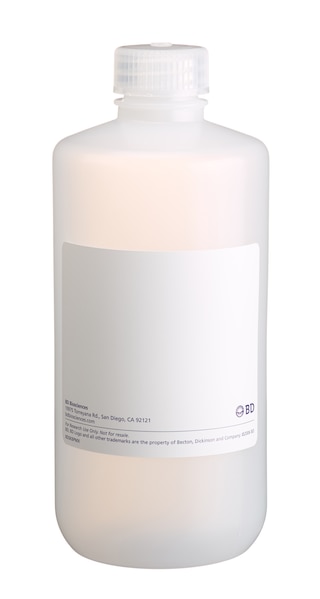Old Browser
This page has been recently translated and is available in French now.
Looks like you're visiting us from {countryName}.
Would you like to stay on the current country site or be switched to your country?


.png)

Flow cytometric analysis of CD48 on mouse splenocytes. Splenocytes from a BALB/c mouse were stained with either APC Hamster IgG1, λ1 Isotype Control (Cat. No.553956; dashed line histogram) or APC Hamster Anti-Mouse CD48 antibody (Cat. No. 562746; solid line histogram). Flow cytometric histograms were derived from gated events with the forward and side light-scattering characteristics of viable cells. Flow cytometry was performed on a BD™ LSR II Flow Cytometry System.
.png)

BD Pharmingen™ APC Hamster Anti-Mouse CD48
.png)
Regulatory Status Legend
Any use of products other than the permitted use without the express written authorization of Becton, Dickinson and Company is strictly prohibited.
Preparation And Storage
Product Notices
- Since applications vary, each investigator should titrate the reagent to obtain optimal results.
- An isotype control should be used at the same concentration as the antibody of interest.
- Please refer to www.bdbiosciences.com/us/s/resources for technical protocols.
- Caution: Sodium azide yields highly toxic hydrazoic acid under acidic conditions. Dilute azide compounds in running water before discarding to avoid accumulation of potentially explosive deposits in plumbing.
- This APC-conjugated reagent can be used in any flow cytometer equipped with a dye, HeNe, or red diode laser.
- For fluorochrome spectra and suitable instrument settings, please refer to our Multicolor Flow Cytometry web page at www.bdbiosciences.com/colors.
Companion Products

.png?imwidth=320)
The HM48-1 monoclonal antibody specifically binds to CD48 (previously known as BCM1 in mice, Blast-1 in human, and OX-45 in the rat), a GPI-anchored member of the Ig superfamily. It is widely distributed on leukocytes, but not on non-hematopoietic cells, and its ligands include CD2 (LFA-2) and CD244 (2B4 antigen). The HM48-1 mAb blocks binding of soluble CD2 to CD48-bearing cells, blocks the interaction of CD2 and CD244, inhibits spleen cell proliferative responses to mitogens, augments the proliferative response of spleen cells when cross-linked with anti-CD3e mAbs, and inhibits priming of CTL in vitro. In vivo administration of HM48-1 antibody can prolong survival of cardiac allografts, an effect which is greatly enhanced by the addition of anti-CD2 mAb 12-15. This hamster mAb to a mouse leukocyte antigen does not cross-react with rat leukocytes.

Development References (5)
-
Brown MH, Boles K, van der Merwe PA, Kumar V, Mathew PA, Barclay AN. 2B4, the natural killer and T cell immunoglobulin superfamily surface protein, is a ligand for CD48. J Exp Med. 1998; 188(11):2083-2090. (Biology). View Reference
-
Kato K, Koyanagi M, Okada H, et al. CD48 is a counter-receptor for mouse CD2 and is involved in T cell activation. J Exp Med. 1992; 176(5):1241-1249. (Immunogen: Blocking, (Co)-stimulation, ELISA, Flow cytometry, Immunoaffinity chromatography, Immunoprecipitation, Inhibition, Western blot). View Reference
-
Latchman Y, McKay PF, Reiser H. Identification of the 2B4 molecule as a counter-receptor for CD48. J Immunol. 1998; 161(11):5809-5812. (Biology). View Reference
-
Qin L, Chavin KD, Lin J, Yagita H, Bromberg JS. Anti-CD2 receptor and anti-CD2 ligand (CD48) antibodies synergize to prolong allograft survival. J Exp Med. 1994; 179(1):341-346. (Biology). View Reference
-
Wong YW, Williams AF, Kingsmore SF, Seldin MF. Structure, expression, and genetic linkage of the mouse BCM1 (OX45 or Blast-1) antigen. Evidence for genetic duplication giving rise to the BCM1 region on mouse chromosome 1 and the CD2/LFA3 region on mouse chromosome 3. J Exp Med. 1990; 171(6):2115-2130. (Biology). View Reference
Please refer to Support Documents for Quality Certificates
Global - Refer to manufacturer's instructions for use and related User Manuals and Technical data sheets before using this products as described
Comparisons, where applicable, are made against older BD Technology, manual methods or are general performance claims. Comparisons are not made against non-BD technologies, unless otherwise noted.
For Research Use Only. Not for use in diagnostic or therapeutic procedures.
Report a Site Issue
This form is intended to help us improve our website experience. For other support, please visit our Contact Us page.